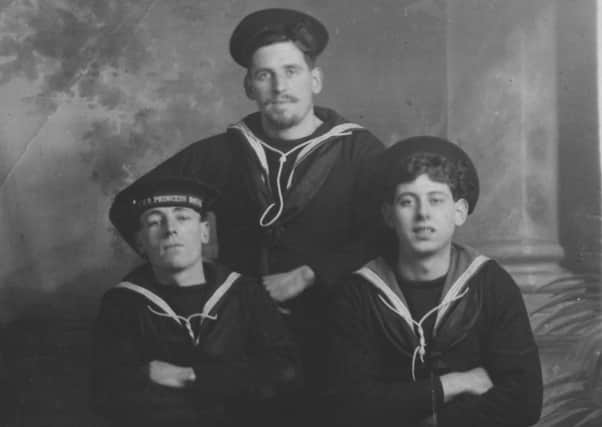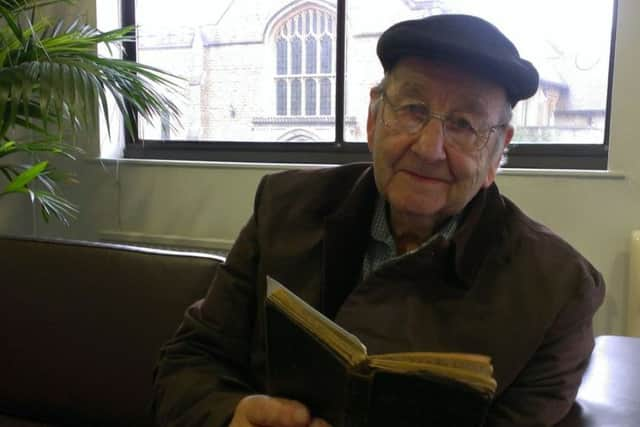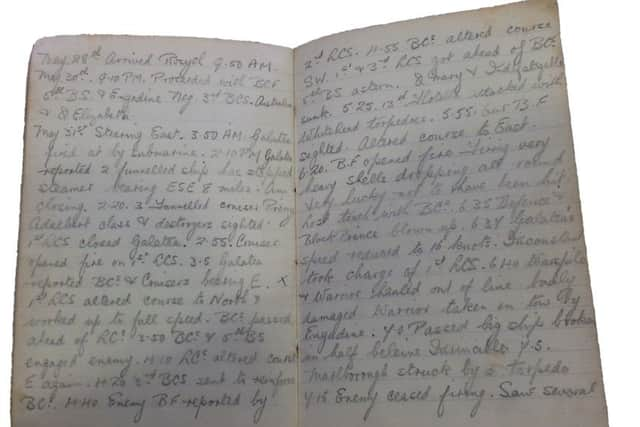Diary of a Burgess Hill boy at the Battle of Jutland
This article contains affiliate links. We may earn a small commission on items purchased through this article, but that does not affect our editorial judgement.


One lad from Burgess Hill fought in what has been called the biggest sea battle of all time and, on top of manning his post and no doubt fighting down waves of fear, he kept a diary.
His name was Walter Lovell and he was 18 or 19 yeasr old when his ship, HMS Princess Royal, saw action in the Battle of Jutland on May 31 and June 1 1916, a the height of the First World War.
Advertisement
Hide AdAdvertisement
Hide AdWith the centenary of the battle approaching, Walter’s 88-year-old son Lewis shared the diary with the Mid Sussex Times.


The little brown book is full of notes and times and details of the ship’s heading and speed as well as information about other vessels as they were lost to German torpedoes.
The entries for May 31 start with a simple “steering east”, before the 3.50am entry reports the HMS Galatea had been fired at by a submarine.
That afternoon, Galatea reported a two-funnelled ship had “stopped steamer bearing east-south-east” before more battle cruisers and destroyers were spotted.
Advertisement
Hide AdAdvertisement
Hide AdThe battle was joined and it’s hard to imagine how such a young man as Walter could valiantly stand his ground as the sea around him filled with fire and oil and the cries of the dying.


But stand he did, snatching seconds to open his diary and make neat entries in pencil, which gave a calm account of the horror around him.
Just over two hours after the battle cruisers and destroyers were spotted, the young leading signalman made a note in his diary that the HMS Queen Mary and HMS Indefatigable had been sunk. Little did he know, but his friend James Edwards was one of the 1,266 officers and men to perish as the ship fell to a bombardment from the SMS Derfflinger and SMS Seydlitz.
Walter enquired after James in a letter home, which was published on June 13 1916.
Advertisement
Hide AdAdvertisement
Hide AdThe letter said: “I suppose you have seen in the papers that the battle cruiser squadron bore the brunt of the last action, so you can guess I have had rather an exciting time; in fact it was a bit too exciting at times as we were right in the thick of it.


“Our squadron was the first to sight the German fleet. I had the sight of a lifetime as I was able to see nearly everything that happened.
“Has anyone heard anything of J Edwards? I do not know if he had left the Queen Mary previous to the action. If not I am afraid there is very little hope of his being saved.”
His parents no doubt shared with him the news that James’ death had been recorded in the paper on the same day.
Advertisement
Hide AdAdvertisement
Hide AdThe article read: “AB James Edwards No J5002 of HMS Queen Mary, no doubt went down with his ship in the great Battle of Jutland. He was a son of Mr and Mrs Edwards, of Fairfield Road, and had nearly completed seven years’ service.”


After the Queen Mary was lost, the action was recorded in Walter’s diary more and more regularly.
At 5.25pm he reported the 13th destroyer flotilla was attacked with whitehead torpedoes, and at 5.55pm a German battle fleet was sighted.
At 6.20pm Walter wrote: “Battle fleet opened fire. Firing very heavy shells, dropping all round. Very lucky not to have been hit. Lost touch with battle cruisers.” At 6.35pm, he saw HMS Defence sank and HMS and Black Prince blown up.
Advertisement
Hide AdAdvertisement
Hide AdBurgess Hill lost two more sons when the Black Prince floundered. The same article which reported James Edwards’ death stated: “Arthur John Pratt, signal boy No J35412, of HMS Black Prince, met a similar fate. He joined on January 29 1915 and his father and mother live in Newport Road, Burgess Hill. S Marchant 1st class boy, HMS Black Prince, was also lost. He was formerly at St Luke’s Home for Boys, Burgess Hill.” Walter’s diary entries for the early evening painted a picture of the losses endured by both sides and the horrors he and the other men must have faced.
At 6.50pm he wrote: “Warspite and Warrior hauled out of line, badly damaged.
“Warrior taken in tow by Engadine; 7.00 Passed big ship broken in half, believe Invincible; 7.05 Marlborough struck by a torpedo; 7.15 Enemy ceased firing. Saw several ships on fire in enemy lines.” He continued: “8.15 Passed large patch of oil fuel wreckage, whaler skiff and dead bodies; 8.25 Battle cruisers again opened fire. Enemy replied. Shells dropping all around us. 1st Light Cruiser Squadron hauled out to port beam of battle cruisers. Hit with shell splinters. No one hurt.”
The battle continued through the night into June 1 and Walter described the rescuing men stranded in the water when their ships were blown from beneath them; the HMS Cordelia’s efforts to destroy mines; and the 3rd Light Cruiser Squadron’s battle with a Zeppelin.
Advertisement
Hide AdAdvertisement
Hide AdHe even stood witness to the fate of the HMS Sparrowhawk, which wsa so badly damaged the captain of the HMS Marksman opted to scuttle her rather than see her fall into enemy hands.
Walter simply wrote: “Sparrowhawk blown up by Marksman, survivors saved.”
At 1.25pm on June 1, HMS Princess Royal headed for base, docking at Rosyth, Scotland 19 hours later.
Walter’s letter home continued: “I am afraid my last ship has been knocked about rather badly this time. I can assure you that we had by far the better of the action, and from what I saw the Germans lost more than is stated in the papers.
Advertisement
Hide AdAdvertisement
Hide Ad“I do not think they will come out again for some time - I beleive they had quite enough. They moved off pretty quickly when our Grand Fleet started at them anyhow!
“I saw in one paper that the Germans claim to have sunk the four light cruisers that first sighted them, but we are all right and ready again.”
Walter’s diary ended on August 31 1916 with the final entry noting that he had “carried out torpedo running”. As he said in his letter home, the HMS Princess Royal wasn’t the only ship on which he served.
At the front of the diary he listed HMS Inflexible, HMS Formidable, HMS Drake and HMS Princess Royal. There was also a note about HM TB 027, 4, and 98 which were probably torpedo boats.
Advertisement
Hide AdAdvertisement
Hide AdHis son, Lewis, said Walter was on the flagship HMS Marlborough when the German fleet was scuttled at Scapa Flow on June 21 1919.
Walter Lovell went on to serve in the Second World War, despite being turned down initially because of his age.
He died in 1963.
Don’t miss out on all the latest breaking news where you live.
Here are four ways you can be sure you’ll be amongst the first to know what’s going on.
Advertisement
Hide AdAdvertisement
Hide Ad1) Make our website your homepage at www.midsussextimes.co.uk
2) Like our Facebook page at www.facebook.com/midsussextimes
3) Follow us on Twitter @midsussex_times
4) Register with us by clicking on ‘sign in’ (top right corner). You can then receive our daily newsletter AND add your point of view to stories that you read here.
And do share with your family and friends - so they don’t miss out!
The Mid Sussex Times - always the first with your local news.
Be part of it.